Antibody data
- Antibody Data
- Antigen structure
- References [57]
- Comments [0]
- Validations
- Western blot [2]
- Immunohistochemistry [1]
- Other assay [3]
Submit
Validation data
Reference
Comment
Report error
- Product number
- MA5-11803 - Provider product page

- Provider
- Invitrogen Antibodies
- Product name
- Involucrin Monoclonal Antibody (SY5)
- Antibody type
- Monoclonal
- Antigen
- Other
- Description
- MA5-11803 targets Involucrin in ELISA, IF, IHC (P), IP, and WB applications and shows reactivity with Canine, Human, Non-human primate, Porcine, and Rat samples. The MA5-11803 immunogen is human keratinocytes' involucrin.
- Reactivity
- Human, Rat, Canine, Porcine
- Host
- Mouse
- Isotype
- IgG
- Antibody clone number
- SY5
- Vial size
- 500 µL
- Concentration
- 0.2 mg/mL
- Storage
- 4° C
Submitted references Differentiation-related zinc finger protein 750 suppresses cell growth in esophageal squamous cell carcinoma.
Interferon Kappa Is Important for Keratinocyte Host Defense against Herpes Simplex Virus-1.
Essential Functions of Glycans in Human Epithelia Dissected by a CRISPR-Cas9-Engineered Human Organotypic Skin Model.
Head and Neck Cancer Stem Cell-Enriched Spheroid Model for Anticancer Compound Screening.
Rab25 Deficiency Perturbs Epidermal Differentiation and Skin Barrier Function in Mice.
Extracellular Vesicles in Human Skin: Cross-Talk from Senescent Fibroblasts to Keratinocytes by miRNAs.
Prolonging culture of primary human keratinocytes isolated from suction blisters with the Rho kinase inhibitor Y-27632.
Differential glucose requirement in skin homeostasis and injury identifies a therapeutic target for psoriasis.
The carboxy-terminus of p63 links cell cycle control and the proliferative potential of epidermal progenitor cells.
Growth and differentiation of HaCaT keratinocytes.
Insulin-transferrin-selenium as an alternative to foetal serum for epidermal equivalents.
B-Myb enhances proliferation and suppresses differentiation of keratinocytes in three-dimensional cell culture.
Disrupted ectodermal organ morphogenesis in mice with a conditional histone deacetylase 1, 2 deletion in the epidermis.
HIV nucleoside reverse transcriptase inhibitors efavirenz and tenofovir change the growth and differentiation of primary gingival epithelium.
Optimizing in vitro culture conditions leads to a significantly shorter production time of human dermo-epidermal skin substitutes.
Nestin expression is increased in the suprabasal epidermal layer in psoriasis vulgaris.
Saurian papulosis: a new clinicopathological entity.
Effects of keratinocyte growth factor on skin epithelial differentiation of human amnion epithelial cells.
Effect of the HIV nucleoside reverse transcriptase inhibitor zidovudine on the growth and differentiation of primary gingival epithelium.
An insight into the role of barrier related skin proteins.
Low-temperature electrospun silk scaffold for in vitro mucosal modeling.
Hsp40 regulates the amount of keratin proteins via ubiquitin-proteasome pathway in cultured human cells.
Progressive alopecia reveals decreasing stem cell activation probability during aging of mice with epidermal deletion of DNA methyltransferase 1.
Id-1 induces cell invasiveness in immortalized epithelial cells by regulating cadherin switching and Rho GTPases.
CD44 regulates tight-junction assembly and barrier function.
Potential localization of putative stem/progenitor cells in human bulbar conjunctival epithelium.
Transglutaminases, involucrin, and loricrin as markers of epidermal differentiation in skin substitutes derived from human sweat gland cells.
Human embryonic stem cell-derived keratinocytes exhibit an epidermal transcription program and undergo epithelial morphogenesis in engineered tissue constructs.
Human eccrine sweat gland cells can reconstitute a stratified epidermis.
Microenvironmental reprogramming of thymic epithelial cells to skin multipotent stem cells.
Methods to promote Notch signaling at the biomaterial interface and evaluation in a rafted organ culture model.
Differential gene expression in primary human skin keratinocytes and fibroblasts in response to ionizing radiation.
Establishment and characterization of immortalized human gingival keratinocyte cell lines.
Squamous metaplasia amplifies pathologic epithelial-mesenchymal interactions in COPD patients.
p63 Is essential for the proliferative potential of stem cells in stratified epithelia.
Tight junction components occludin, ZO-1, and claudin-1, -4 and -5 in active and healing psoriasis.
Isolation and characterization of putative epidermal stem cells derived from Cashmere goat fetus.
Regulation of calprotectin expression by interleukin-1alpha and transforming growth factor-beta in human gingival keratinocytes.
Gene transfer in human skin with different pseudotyped HIV-based vectors.
Improved transduction of human corneal epithelial progenitor cells with cell-targeting adenoviral vectors.
Mimicking cell-cell interactions at the biomaterial-cell interface for control of stem cell differentiation.
Gap junction protein connexin 43 serves as a negative marker for a stem cell-containing population of human limbal epithelial cells.
Engraftment of umbilical cord epithelial cells in athymic mice: in an attempt to improve reconstructed skin equivalents used as epithelial composite.
Long-term maintenance of human keratinocytes in vitro.
Partial enrichment of a population of human limbal epithelial cells with putative stem cell properties based on collagen type IV adhesiveness.
Characterization of putative stem cell phenotype in human limbal epithelia.
Organotypic culture and surface plantation using umbilical cord epithelial cells: morphogenesis and expression of differentiation markers mimicking cutaneous epidermis.
Enhanced redundancy in Akt and mitogen-activated protein kinase-induced survival of malignant versus normal prostate epithelial cells.
Abnormal development of thymic dendritic and epithelial cells in human X-linked severe combined immunodeficiency.
Corticosteroids regulate epithelial cell differentiation and Hassall body formation in the human thymus.
Corticosteroids regulate epithelial cell differentiation and Hassall body formation in the human thymus.
Rap1, a small GTP-binding protein is upregulated during arrest of proliferation in human keratinocytes.
Organotypic keratinocyte coculture using normal human serum: an immunomorphological study at light and electron microscopic levels.
Organotypic keratinocyte coculture using normal human serum: an immunomorphological study at light and electron microscopic levels.
Microtubule disruption in keratinocytes induces cell-cell adhesion through activation of endogenous E-cadherin.
Microtubule disruption in keratinocytes induces cell-cell adhesion through activation of endogenous E-cadherin.
Bacterial fimbriae and their peptides activate human gingival epithelial cells through Toll-like receptor 2.
Ana Choi SS, Ko JM, Yu VZ, Ning L, Lung ML
Oncology letters 2021 Jul;22(1):513
Oncology letters 2021 Jul;22(1):513
Interferon Kappa Is Important for Keratinocyte Host Defense against Herpes Simplex Virus-1.
Li Y, Song Y, Zhu L, Wang X, Richers B, Leung DYM, Bin L
Journal of immunology research 2020;2020:5084682
Journal of immunology research 2020;2020:5084682
Essential Functions of Glycans in Human Epithelia Dissected by a CRISPR-Cas9-Engineered Human Organotypic Skin Model.
Dabelsteen S, Pallesen EMH, Marinova IN, Nielsen MI, Adamopoulou M, Rømer TB, Levann A, Andersen MM, Ye Z, Thein D, Bennett EP, Büll C, Moons SJ, Boltje T, Clausen H, Vakhrushev SY, Bagdonaite I, Wandall HH
Developmental cell 2020 Sep 14;54(5):669-684.e7
Developmental cell 2020 Sep 14;54(5):669-684.e7
Head and Neck Cancer Stem Cell-Enriched Spheroid Model for Anticancer Compound Screening.
Goričan L, Gole B, Potočnik U
Cells 2020 Jul 16;9(7)
Cells 2020 Jul 16;9(7)
Rab25 Deficiency Perturbs Epidermal Differentiation and Skin Barrier Function in Mice.
Jeong H, Lim KM, Goldenring JR, Nam KT
Biomolecules & therapeutics 2019 Nov 1;27(6):553-561
Biomolecules & therapeutics 2019 Nov 1;27(6):553-561
Extracellular Vesicles in Human Skin: Cross-Talk from Senescent Fibroblasts to Keratinocytes by miRNAs.
Terlecki-Zaniewicz L, Pils V, Bobbili MR, Lämmermann I, Perrotta I, Grillenberger T, Schwestka J, Weiß K, Pum D, Arcalis E, Schwingenschuh S, Birngruber T, Brandstetter M, Heuser T, Schosserer M, Morizot F, Mildner M, Stöger E, Tschachler E, Weinmüllner R, Gruber F, Grillari J
The Journal of investigative dermatology 2019 Dec;139(12):2425-2436.e5
The Journal of investigative dermatology 2019 Dec;139(12):2425-2436.e5
Prolonging culture of primary human keratinocytes isolated from suction blisters with the Rho kinase inhibitor Y-27632.
Anderson ED, Sastalla I, Earland NJ, Mahnaz M, Moore IN, Otaizo-Carrasquero F, Myers TG, Myles CA, Datta SK, Myles IA
PloS one 2018;13(9):e0198862
PloS one 2018;13(9):e0198862
Differential glucose requirement in skin homeostasis and injury identifies a therapeutic target for psoriasis.
Zhang Z, Zi Z, Lee EE, Zhao J, Contreras DC, South AP, Abel ED, Chong BF, Vandergriff T, Hosler GA, Scherer PE, Mettlen M, Rathmell JC, DeBerardinis RJ, Wang RC
Nature medicine 2018 May;24(5):617-627
Nature medicine 2018 May;24(5):617-627
The carboxy-terminus of p63 links cell cycle control and the proliferative potential of epidermal progenitor cells.
Suzuki D, Sahu R, Leu NA, Senoo M
Development (Cambridge, England) 2015 Jan 15;142(2):282-90
Development (Cambridge, England) 2015 Jan 15;142(2):282-90
Growth and differentiation of HaCaT keratinocytes.
Wilson VG
Methods in molecular biology (Clifton, N.J.) 2014;1195:33-41
Methods in molecular biology (Clifton, N.J.) 2014;1195:33-41
Insulin-transferrin-selenium as an alternative to foetal serum for epidermal equivalents.
Mainzer C, Barrichello C, Debret R, Remoué N, Sigaudo-Roussel D, Sommer P
International journal of cosmetic science 2014 Oct;36(5):427-35
International journal of cosmetic science 2014 Oct;36(5):427-35
B-Myb enhances proliferation and suppresses differentiation of keratinocytes in three-dimensional cell culture.
Maruyama H, Ishitsuka Y, Fujisawa Y, Furuta J, Sekido M, Kawachi Y
Archives of dermatological research 2014 May;306(4):375-84
Archives of dermatological research 2014 May;306(4):375-84
Disrupted ectodermal organ morphogenesis in mice with a conditional histone deacetylase 1, 2 deletion in the epidermis.
Hughes MW, Jiang TX, Lin SJ, Leung Y, Kobielak K, Widelitz RB, Chuong CM
The Journal of investigative dermatology 2014 Jan;134(1):24-32
The Journal of investigative dermatology 2014 Jan;134(1):24-32
HIV nucleoside reverse transcriptase inhibitors efavirenz and tenofovir change the growth and differentiation of primary gingival epithelium.
Mitchell D, Israr M, Alam S, Dinello D, Kishel J, Jia R, Meyers C
HIV medicine 2014 Apr;15(4):196-202
HIV medicine 2014 Apr;15(4):196-202
Optimizing in vitro culture conditions leads to a significantly shorter production time of human dermo-epidermal skin substitutes.
Pontiggia L, Klar A, Böttcher-Haberzeth S, Biedermann T, Meuli M, Reichmann E
Pediatric surgery international 2013 Mar;29(3):249-56
Pediatric surgery international 2013 Mar;29(3):249-56
Nestin expression is increased in the suprabasal epidermal layer in psoriasis vulgaris.
Watarai A, Amoh Y, Maejima H, Hamada Y, Katsuoka K
Acta dermato-venereologica 2013 Jan;93(1):39-43
Acta dermato-venereologica 2013 Jan;93(1):39-43
Saurian papulosis: a new clinicopathological entity.
Molina-Ruiz AM, del Carmen Fariña M, Carrasco L, Santonja C, Rodríguez-Peralto JL, Torrelo A, Kutzner H, Requena L
Journal of the American Academy of Dermatology 2013 Feb;68(2):e17-22
Journal of the American Academy of Dermatology 2013 Feb;68(2):e17-22
Effects of keratinocyte growth factor on skin epithelial differentiation of human amnion epithelial cells.
Fatimah SS, Tan GC, Chua K, Tan AE, Nur Azurah AG, Hayati AR
Burns : journal of the International Society for Burn Injuries 2013 Aug;39(5):905-15
Burns : journal of the International Society for Burn Injuries 2013 Aug;39(5):905-15
Effect of the HIV nucleoside reverse transcriptase inhibitor zidovudine on the growth and differentiation of primary gingival epithelium.
Mitchell D, Israr M, Alam S, Kishel J, Dinello D, Meyers C
HIV medicine 2012 May;13(5):276-90
HIV medicine 2012 May;13(5):276-90
An insight into the role of barrier related skin proteins.
Wato K, Hara T, Yamana K, Nakao H, Inagi T, Terada K
International journal of pharmaceutics 2012 May 10;427(2):293-8
International journal of pharmaceutics 2012 May 10;427(2):293-8
Low-temperature electrospun silk scaffold for in vitro mucosal modeling.
Bulysheva AA, Bowlin GL, Klingelhutz AJ, Yeudall WA
Journal of biomedical materials research. Part A 2012 Mar;100(3):757-67
Journal of biomedical materials research. Part A 2012 Mar;100(3):757-67
Hsp40 regulates the amount of keratin proteins via ubiquitin-proteasome pathway in cultured human cells.
Yamazaki S, Uchiumi A, Katagata Y
International journal of molecular medicine 2012 Feb;29(2):165-8
International journal of molecular medicine 2012 Feb;29(2):165-8
Progressive alopecia reveals decreasing stem cell activation probability during aging of mice with epidermal deletion of DNA methyltransferase 1.
Li J, Jiang TX, Hughes MW, Wu P, Yu J, Widelitz RB, Fan G, Chuong CM
The Journal of investigative dermatology 2012 Dec;132(12):2681-90
The Journal of investigative dermatology 2012 Dec;132(12):2681-90
Id-1 induces cell invasiveness in immortalized epithelial cells by regulating cadherin switching and Rho GTPases.
Cheung PY, Yip YL, Tsao SW, Ching YP, Cheung AL
Journal of cellular biochemistry 2011 Jan;112(1):157-68
Journal of cellular biochemistry 2011 Jan;112(1):157-68
CD44 regulates tight-junction assembly and barrier function.
Kirschner N, Haftek M, Niessen CM, Behne MJ, Furuse M, Moll I, Brandner JM
The Journal of investigative dermatology 2011 Apr;131(4):932-43
The Journal of investigative dermatology 2011 Apr;131(4):932-43
Potential localization of putative stem/progenitor cells in human bulbar conjunctival epithelium.
Qi H, Zheng X, Yuan X, Pflugfelder SC, Li DQ
Journal of cellular physiology 2010 Oct;225(1):180-5
Journal of cellular physiology 2010 Oct;225(1):180-5
Transglutaminases, involucrin, and loricrin as markers of epidermal differentiation in skin substitutes derived from human sweat gland cells.
Tharakan S, Pontiggia L, Biedermann T, Böttcher-Haberzeth S, Schiestl C, Reichmann E, Meuli M
Pediatric surgery international 2010 Jan;26(1):71-7
Pediatric surgery international 2010 Jan;26(1):71-7
Human embryonic stem cell-derived keratinocytes exhibit an epidermal transcription program and undergo epithelial morphogenesis in engineered tissue constructs.
Metallo CM, Azarin SM, Moses LE, Ji L, de Pablo JJ, Palecek SP
Tissue engineering. Part A 2010 Jan;16(1):213-23
Tissue engineering. Part A 2010 Jan;16(1):213-23
Human eccrine sweat gland cells can reconstitute a stratified epidermis.
Biedermann T, Pontiggia L, Böttcher-Haberzeth S, Tharakan S, Braziulis E, Schiestl C, Meuli M, Reichmann E
The Journal of investigative dermatology 2010 Aug;130(8):1996-2009
The Journal of investigative dermatology 2010 Aug;130(8):1996-2009
Microenvironmental reprogramming of thymic epithelial cells to skin multipotent stem cells.
Bonfanti P, Claudinot S, Amici AW, Farley A, Blackburn CC, Barrandon Y
Nature 2010 Aug 19;466(7309):978-82
Nature 2010 Aug 19;466(7309):978-82
Methods to promote Notch signaling at the biomaterial interface and evaluation in a rafted organ culture model.
Beckstead BL, Tung JC, Liang KJ, Tavakkol Z, Usui ML, Olerud JE, Giachelli CM
Journal of biomedical materials research. Part A 2009 Nov;91(2):436-46
Journal of biomedical materials research. Part A 2009 Nov;91(2):436-46
Differential gene expression in primary human skin keratinocytes and fibroblasts in response to ionizing radiation.
Warters RL, Packard AT, Kramer GF, Gaffney DK, Moos PJ
Radiation research 2009 Jul;172(1):82-95
Radiation research 2009 Jul;172(1):82-95
Establishment and characterization of immortalized human gingival keratinocyte cell lines.
Gröger S, Michel J, Meyle J
Journal of periodontal research 2008 Dec;43(6):604-14
Journal of periodontal research 2008 Dec;43(6):604-14
Squamous metaplasia amplifies pathologic epithelial-mesenchymal interactions in COPD patients.
Araya J, Cambier S, Markovics JA, Wolters P, Jablons D, Hill A, Finkbeiner W, Jones K, Broaddus VC, Sheppard D, Barzcak A, Xiao Y, Erle DJ, Nishimura SL
The Journal of clinical investigation 2007 Nov;117(11):3551-62
The Journal of clinical investigation 2007 Nov;117(11):3551-62
p63 Is essential for the proliferative potential of stem cells in stratified epithelia.
Senoo M, Pinto F, Crum CP, McKeon F
Cell 2007 May 4;129(3):523-36
Cell 2007 May 4;129(3):523-36
Tight junction components occludin, ZO-1, and claudin-1, -4 and -5 in active and healing psoriasis.
Peltonen S, Riehokainen J, Pummi K, Peltonen J
The British journal of dermatology 2007 Mar;156(3):466-72
The British journal of dermatology 2007 Mar;156(3):466-72
Isolation and characterization of putative epidermal stem cells derived from Cashmere goat fetus.
Islam MS, Zhou H
European journal of dermatology : EJD 2007 Jul-Aug;17(4):302-8
European journal of dermatology : EJD 2007 Jul-Aug;17(4):302-8
Regulation of calprotectin expression by interleukin-1alpha and transforming growth factor-beta in human gingival keratinocytes.
Hayashi N, Kido J, Kido R, Wada C, Kataoka M, Shinohara Y, Nagata T
Journal of periodontal research 2007 Feb;42(1):1-7
Journal of periodontal research 2007 Feb;42(1):1-7
Gene transfer in human skin with different pseudotyped HIV-based vectors.
Hachiya A, Sriwiriyanont P, Patel A, Saito N, Ohuchi A, Kitahara T, Takema Y, Tsuboi R, Boissy RE, Visscher MO, Wilson JM, Kobinger GP
Gene therapy 2007 Apr;14(8):648-56
Gene therapy 2007 Apr;14(8):648-56
Improved transduction of human corneal epithelial progenitor cells with cell-targeting adenoviral vectors.
Chen Z, Mok H, Pflugfelder SC, Li DQ, Barry MA
Experimental eye research 2006 Oct;83(4):798-806
Experimental eye research 2006 Oct;83(4):798-806
Mimicking cell-cell interactions at the biomaterial-cell interface for control of stem cell differentiation.
Beckstead BL, Santosa DM, Giachelli CM
Journal of biomedical materials research. Part A 2006 Oct;79(1):94-103
Journal of biomedical materials research. Part A 2006 Oct;79(1):94-103
Gap junction protein connexin 43 serves as a negative marker for a stem cell-containing population of human limbal epithelial cells.
Chen Z, Evans WH, Pflugfelder SC, Li DQ
Stem cells (Dayton, Ohio) 2006 May;24(5):1265-73
Stem cells (Dayton, Ohio) 2006 May;24(5):1265-73
Engraftment of umbilical cord epithelial cells in athymic mice: in an attempt to improve reconstructed skin equivalents used as epithelial composite.
Sanmano B, Mizoguchi M, Suga Y, Ikeda S, Ogawa H
Journal of dermatological science 2005 Jan;37(1):29-39
Journal of dermatological science 2005 Jan;37(1):29-39
Long-term maintenance of human keratinocytes in vitro.
Hasskarl J, Velupillai P, Piboonniyom SO, Grace M, Münger K
The Journal of investigative dermatology 2005 Feb;124(2):475-8
The Journal of investigative dermatology 2005 Feb;124(2):475-8
Partial enrichment of a population of human limbal epithelial cells with putative stem cell properties based on collagen type IV adhesiveness.
Li DQ, Chen Z, Song XJ, de Paiva CS, Kim HS, Pflugfelder SC
Experimental eye research 2005 Apr;80(4):581-90
Experimental eye research 2005 Apr;80(4):581-90
Characterization of putative stem cell phenotype in human limbal epithelia.
Chen Z, de Paiva CS, Luo L, Kretzer FL, Pflugfelder SC, Li DQ
Stem cells (Dayton, Ohio) 2004;22(3):355-66
Stem cells (Dayton, Ohio) 2004;22(3):355-66
Organotypic culture and surface plantation using umbilical cord epithelial cells: morphogenesis and expression of differentiation markers mimicking cutaneous epidermis.
Mizoguchi M, Suga Y, Sanmano B, Ikeda S, Ogawa H
Journal of dermatological science 2004 Sep;35(3):199-206
Journal of dermatological science 2004 Sep;35(3):199-206
Enhanced redundancy in Akt and mitogen-activated protein kinase-induced survival of malignant versus normal prostate epithelial cells.
Uzgare AR, Isaacs JT
Cancer research 2004 Sep 1;64(17):6190-9
Cancer research 2004 Sep 1;64(17):6190-9
Abnormal development of thymic dendritic and epithelial cells in human X-linked severe combined immunodeficiency.
Hale LP, Buckley RH, Puck JM, Patel DD
Clinical immunology (Orlando, Fla.) 2004 Jan;110(1):63-70
Clinical immunology (Orlando, Fla.) 2004 Jan;110(1):63-70
Corticosteroids regulate epithelial cell differentiation and Hassall body formation in the human thymus.
Hale LP, Markert ML
Journal of immunology (Baltimore, Md. : 1950) 2004 Jan 1;172(1):617-24
Journal of immunology (Baltimore, Md. : 1950) 2004 Jan 1;172(1):617-24
Corticosteroids regulate epithelial cell differentiation and Hassall body formation in the human thymus.
Hale LP, Markert ML
Journal of immunology (Baltimore, Md. : 1950) 2004 Jan 1;172(1):617-24
Journal of immunology (Baltimore, Md. : 1950) 2004 Jan 1;172(1):617-24
Rap1, a small GTP-binding protein is upregulated during arrest of proliferation in human keratinocytes.
D'Silva NJ, Mitra RS, Zhang Z, Kurnit DM, Babcock CR, Polverini PJ, Carey TE
Journal of cellular physiology 2003 Sep;196(3):532-40
Journal of cellular physiology 2003 Sep;196(3):532-40
Organotypic keratinocyte coculture using normal human serum: an immunomorphological study at light and electron microscopic levels.
Hinterhuber G, Marquardt Y, Diem E, Rappersberger K, Wolff K, Foedinger D
Experimental dermatology 2002 Oct;11(5):413-20
Experimental dermatology 2002 Oct;11(5):413-20
Organotypic keratinocyte coculture using normal human serum: an immunomorphological study at light and electron microscopic levels.
Hinterhuber G, Marquardt Y, Diem E, Rappersberger K, Wolff K, Foedinger D
Experimental dermatology 2002 Oct;11(5):413-20
Experimental dermatology 2002 Oct;11(5):413-20
Microtubule disruption in keratinocytes induces cell-cell adhesion through activation of endogenous E-cadherin.
Kee SH, Steinert PM
Molecular biology of the cell 2001 Jul;12(7):1983-93
Molecular biology of the cell 2001 Jul;12(7):1983-93
Microtubule disruption in keratinocytes induces cell-cell adhesion through activation of endogenous E-cadherin.
Kee SH, Steinert PM
Molecular biology of the cell 2001 Jul;12(7):1983-93
Molecular biology of the cell 2001 Jul;12(7):1983-93
Bacterial fimbriae and their peptides activate human gingival epithelial cells through Toll-like receptor 2.
Asai Y, Ohyama Y, Gen K, Ogawa T
Infection and immunity 2001 Dec;69(12):7387-95
Infection and immunity 2001 Dec;69(12):7387-95
No comments: Submit comment
Supportive validation
- Submitted by
- Invitrogen Antibodies (provider)
- Main image

- Experimental details
- Western blot of Involucrin using Involucrin Monoclonal Antibody (Product # MA5-11803) on LS174T Cells.
- Submitted by
- Invitrogen Antibodies (provider)
- Main image
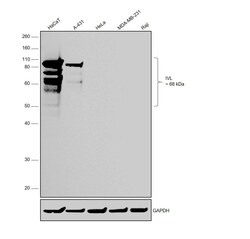
- Experimental details
- Western blot was performed using Anti-Involucrin Monoclonal Antibody (SY5) (Product # MA5-11803) and ~68kDa, ~75kDa, ~100kDa, ~124kDa bands corresponding to Involucrin was observed across skin derived cell lines (HaCaT and A-431) and not in others. Whole Cell Extract-WCL (30 µg lysate) of HaCaT (Lane 1), A-431 (Lane 2), HeLa (Lane 3), MDA-MB-231 (Lane 4) and Raji (Lane 5) were electrophoresed using NuPAGE™ 10% Bis-Tris Protein Gel (Product # NP0301BOX). Resolved proteins were then transferred onto a Nitrocellulose membrane (Product # IB23001) by iBlot® 2 Dry Blotting System (Product # IB21001). The blot was probed with the primary antibody (1ug dilution) and detected by chemiluminescence with Goat anti-Mouse IgG (H+L) Superclonal™ Recombinant Secondary Antibody, HRP (Product # A28177, 1:4000) using the iBright FL 1000 (Product # A32752). Chemiluminescent detection was performed using Novex® ECL Chemiluminescent Substrate Reagent Kit (Product # WP20005). IVL is reported to show this pattern of expression at molecular weights >68kDa and all of these forms are not detected in the low and/or negative cell lines tested [doi:10.1242/jcs.056093; 10.1093/toxsci/kfm153]
Supportive validation
- Submitted by
- Invitrogen Antibodies (provider)
- Main image
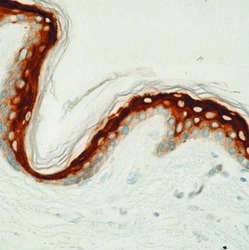
- Experimental details
- Formalin-fixed, paraffin-embedded human skin stained with Involucrin antibody using peroxidase-conjugate and DAB chromogen. Note cytoplasmic staining in the epidermal region.
Supportive validation
- Submitted by
- Invitrogen Antibodies (provider)
- Main image
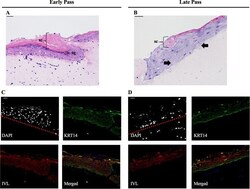
- Experimental details
- Fig 3 Late passage SBK stratify into an epidermis with increased numbers of cornified cells present in the subcorneal layers. Hematoxylin and eosin stain (A, B; size of stratum corneum highlighted as 'SC') and immunofluorescence stain (C, D; green, keratin 14; red, involucrin; blue, DAPI) of organotypic raft cultures derived from early and late passage keratinocytes. Arrow in B indicates cornified cells in the sub-corneal layers. DAPI image presented in black and white to better distinguish the nuclei, and the red dotted line delineates where the epidermis begins. Nuclei below the line are from the 3T3 fibroblasts seeded in the collagen rafts. sc = stratum corneum, sg = stratum granulosum, scale bar = 100muM for both H&E and IF photos, seen in the upper left corner of each figure.
- Submitted by
- Invitrogen Antibodies (provider)
- Main image
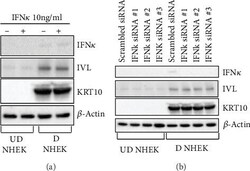
- Experimental details
- Figure 4 IFN kappa does not regulate NHEK differentiation. (a) Western blot assay to detect IFN kappa , IVL, KRT10, and beta -actin in undifferentiated (UD) and differentiated (D) NHEK in the presence and absence of rhIFN kappa . (b) Western blot assay to detect IFN kappa , IVL, KRT10, and beta -actin in IFN kappa -silenced undifferentiated (UD) and differentiated (D) NHEK. One of three independent experiments is presented.
- Submitted by
- Invitrogen Antibodies (provider)
- Main image
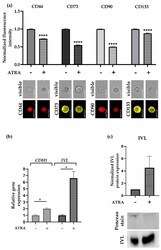
- Experimental details
- Figure 6 All-trans retinoic acid (ATRA) treatment. Seven-day-old SCESM spheroids were treated with 10 muM ATRA for 5 days. ( a ) Normalized fluorescence intensities of selected surface stem markers and corresponding flow cytometry visible light and fluorescent photos are presented. Normalized mean values +- SE ( n >= 5, N >= 2000) are shown. ( b ) Relative gene expression of two differentiation markers, CDH1 and IVL , after 5 days of ATRA treatment are displayed. Normalized mean values +- SE ( n >= 5) are presented. ( c ) IVL protein expression was assessed after 5 days of ATRA treatment by Western blot analysis. Western blot membrane photo showing IVL and Ponceau staining and a graph depicting normalized IVL protein expression analysis from the Western blot membrane, (using Image Lab software) are presented ( n >= 3). (* p < 0.05, **** p < 0.0001 vs. control - ATRA untreated group)--control/ATRA untreated group; +: ATRA treated group.
 Explore
Explore Validate
Validate Learn
Learn Western blot
Western blot ELISA
ELISA